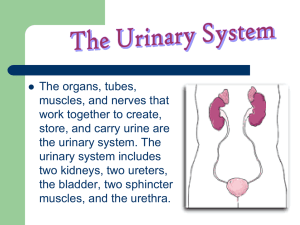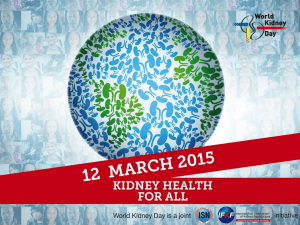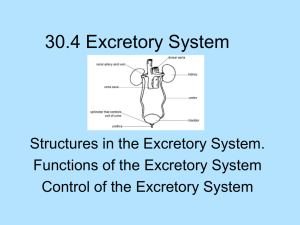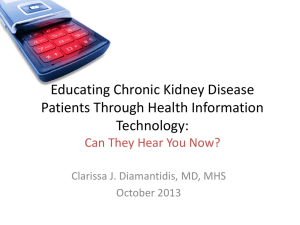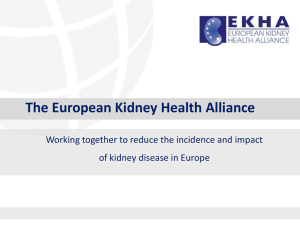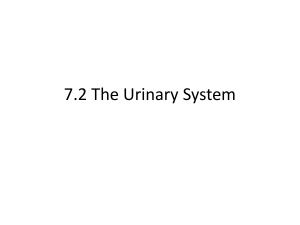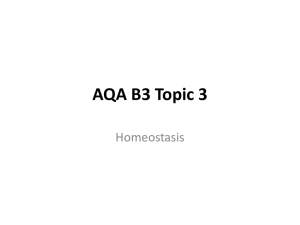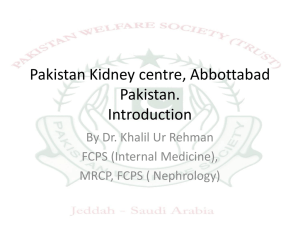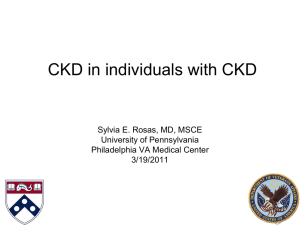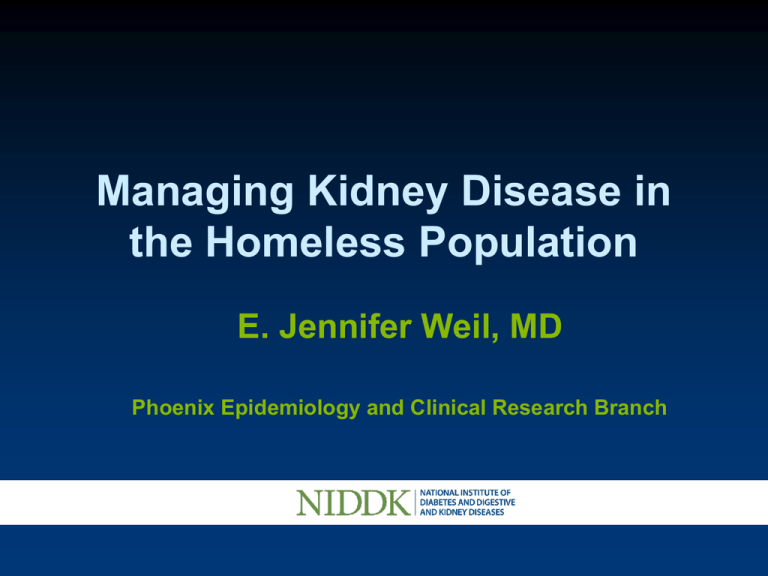
Managing Kidney Disease in
the Homeless Population
E. Jennifer Weil, MD
Phoenix Epidemiology and Clinical Research Branch
Temple University, Philadelphia, PA
in memory of Larry Coleman,
my patient 10/18/99 – 4/31/04
Rest in Peace
What Kidneys Do
Kidneys control the amount of water and other
chemicals in blood.
Kidneys remove harmful substances
Kidneys control blood pressure
Kidneys help make red blood cells
Kidneys promote strong bones
Chronic Kidney Disease
Chronic kidney disease (CKD) is the permanent
loss of kidney function in both kidneys as a result of
Physical injury or
A disease that damages both kidneys, such as DIABETES
Damaged kidneys
do not remove wastes
do not remove extra water
from the blood as well as they should.
What Else About CKD?
CKD is a familial disease. Risk for CKD
increases if a blood relative has kidney
failure.
CKD is a silent condition.
In the early stages, there are no symptoms.
CKD develops so slowly that people don't
realize they're sick until the disease is
advanced and they are rushed to the hospital
for life-saving dialysis.
Kidney Failure is Increasing
in the US
Incident Counts & Adjusted
Rates, by Race
Incident ESRD patients; rates adjusted for age & gender.
Incident Counts and Rates of ESRD
by Primary Diagnosis
illi
illi
lla
lla
USRDS 2006
Kidney Disease Has 5 Stages
Stage Description
Symptoms
1
Slightly damaged
NONE!
2
Cleaning reduced
NONE!
3
Halfway to failure
NONE!
4
On the edge of failing
Could have swelling,
nausea
5
KIDNEY FAILURE –
starting DIALYSIS
Could have swelling,
nausea, shortness of
breath. Need blood test to
know for sure.
A Familiar Filter
Pretend this Filter is in Kidneys..
BLOOD
ALBUMIN
URINE
A Familiar Filter is Damaged
Damaged Kidney Filters
BLOOD
ALBUMIN
URINE
microalbuminuria = micro (small) albumin (protein) uria (urine)
Failing Kidney Filters
SCARS
blood is clean (red)
urine removes
waste (yellow)
plenty of urine
NORMAL
blood is clean (red)
albumin or
red blood cells
urine removes
waste (yellow)
plenty of urine
STAGES 1 & 2
GFR > 59
kidneys don’t
clean blood
as well
scar
albumin or
red blood cells
urine removes
less waste
less urine
STAGE 3
GFR 30 - 59
kidneys don’t
clean blood
as well
scars bigger
albumin or
red blood cells
urine removes
less waste
less urine
STAGE 4
GFR 15-29
too much fluid in heart
scars replace
most of kidneys
kidneys don’t
clean blood
albumin or
red blood cells
urine removes
less waste
very little urine
STAGE 5
GFR < 15
Kidney Disease Has 5 Stages
Stage Description
eGFR
1
Slightly damaged
≥ 90 ml/min
2
Cleaning reduced
60 - 89 ml/min
3
Halfway to failure
30 – 59 ml/min
4
On the edge of failing
15 – 29 ml/min
5
KIDNEY FAILURE –
starting DIALYSIS
< 15 ml/min
Stages 1 & 2
Normal eGFR ≥ 60 ml/m
Kidney damage for more than 3 months as
manifested by
Abnormalities in the tissue of the kidney (biopsy) or
Markers of kidney damage including
Abnormalities in the composition of urine or
Changes seen by radiological images (x-ray, CT scan, ultrasound
etc.)
Risks associated
Progression
Heart disease
Stages 3, 4 & 5
Kidney damage getting worse
eGFR getting progressively lower
Risks associated
Progressive kidney disease (dialysis)
Increased cardiovascular risk
Myocardial infarction (heart attack)
Stroke
Sudden death
How to Stage
Calculate eGFR with age, sex, race, and
creatinine
Find out if there are changes in kidneys for
more than 3 months:
Urinalysis positive for protein or blood OR
Urine albumin to creatinine ratio
(AKA: microalbumin, ACR): > 30 mg/g OR
Ultrasound or other imaging test is abnormal
Look at the table
Kidney Disease Has 5 Stages
Stage Description
1
2
3
4
5
eGFR
≥ 90 ml/min
Slightly damaged
MUST HAVE SIGNS OF
DAMAGE
Damaged and cleaning 60 - 89 ml/min
reduced
MUST HAVE SIGNS OF
DAMAGE
Halfway to failure
30 – 59 ml/min
On the edge of failing
KIDNEY FAILURE –
starting DIALYSIS
15 – 29 ml/min
< 15 ml/min
Quiyo, Tessie
15009
Urine creat
Urine albumin
Microalbumin, random
60.6
25.9
426.9
mg/dL
mg/dL
mg/g
Serum creat
Est GFR
0.9
> 60
mg/dL
ml/m
How to stage: presence of macroalbuminuria
means there is kidney disease present. eGFR > 60
means Stage 1 or Stage 2. Our methods do not
allow distinction between Stages 1 and 2.
Joe, Lalo
12345
Urine creat
Urine albumin
Microalbumin, Random
85.2
2.4
28
mg/dL
mg/dL
mg/g
Serum creat
Est GFR
2.2
34
mg/dL
ml/m
How to stage: no albuminuria but eGFR = 34 ml/m,
Stage 3.
Cachora, Dale
31434
Urine creat
Urine albumin
Microalbumin, Random
60.0 mg/dL
31.5 mg/dL
524.5 mg/g
Serum creat
Est GFR
2.8
25
mg/dL
ml/m
How to stage: presence of macroalbuminuria
means there is kidney disease present. eGFR 25
means Stage 4.
Cachora, Dale
31434
Urinalysis
Serum creat
Est GFR
Blood 3+
Protein 2+
1.4
50
mg/dL
ml/m
How to stage: presence of blood and protein means
there is kidney disease present. eGFR 50 means
Stage 3.
Cachora, Dale
31434
Renal ultrasound
Single kidney
Serum creat
Est GFR
1.1
≥ 60
mg/dL
ml/m
How to stage: single kidney is abnormal, and
eGFR ≥ 60 means Stage 1 or 2.
Columbus Neighborhood Health
Center Study, 2005
35
31.1
30
25.2
25
20.2
20
16
15
10
5
5
1.7
0.8
Stage 4
Stage 5
0
at risk
Stage 1
Stage 2
Stage 3
People with Diabetes or Hypertension
not
stageable
Etiology of CKD
Hypertension
Diabetes
Other
Bilateral renal artery stenosis (heart disease, stroke
patient)
Kidney obstruction (stones, prostate, cancer patient)
Interstitial nephritis (lithium, NSAIDs)
Glomerulonephritis (heroin, HIV, hepatitis C, hepatitis B
patients)
Congenital kidney disease (polycystic, Alport’s etc.)
Multiple myeloma (older patient, anemia)
Lupus (lots of other manifestations in joints, skin, brain)
Complete Work-Up for
Etiology of CKD
Diabetes: duration, A1C, dilated retinal exam,
sensory testing with monofilament
Hypertension: duration, number of meds
Other diseases
Lupus: ANA, C3, C4
Vasculitis: ANCA, Anti-GBM, cryoglobulins
Multiple Myeloma: SPEP with IFE, UPEP with IFE
Infectious Diseases: HBSAg, HCV, HIV screens
Renal Ultrasound for obstruction, small kidneys
or anything else
Core Labs for All Follow-Up
CBC: more frequently in advanced stages
Chem 7: more frequently in advanced stages
Urinalysis: helpful for diagnosis, helpful for UTI
Urine microalbuminuria: helpful at diagnosis and
to see if ACE inhibitor or ARB is working
Lipid panel: check while adjusting lipid meds
HbA1C: if diabetic – every three months
Blood pressure – every visit
When to slow CKD down?
Stage Description
Symptoms
1
Slightly damaged
NONE!
2
Cleaning reduced
NONE!
3
Halfway to failure
NONE!
4
On the edge of failing
Could have swelling,
nausea
5
KIDNEY FAILURE –
starting DIALYSIS
Could have swelling,
nausea, shortness of
breath. Need blood test to
know for sure.
How to Slow CKD
Educate patients on how they can control many of the things that
can make CKD worse and may lead to kidney failure.
Gain tight control of blood glucose to delay or prevent kidney
failure, where appropriate.
Keep blood pressure below 130/80 mm Hg. A combination of two
or more drugs may be necessary
ACE (angiotensin-converting enzyme) inhibitors and ARBs
(angiotensin receptor blockers) protect the kidneys better than other
blood pressure medicines.
Dietary therapy when practicable, low protein, low sodium, and
later low potassium and low phosphorus.
Renoprotective Drugs
ACE inhibitors
Lisinopril (longest half-life)
Captopril
ARBs
Telmisartan (longest half-life)
Candesartan
Enalapril
Ramipril
Fosinopril (hepatic)
others
Valsartan
Losartan
Irbesartan
others
Dosage: maximal tolerated by blood pressure, serum creatinine and
potassium
Combination of ACE inhibitor and ARB: almost always unnecessary
(but combination with other anti-hypertensive drugs to be expected)
Contraindicated: women of childbearing potential, allergic patients
Heart Disease in CKD
Modification of risk
Lipid control
Smoking cessation
Diabetes control
Blood pressure control
Lower albumin or protein in urine
Medicines
Statins, other lipid agents
Anti-hypertensive drugs, especially ACE, ARB, betablocker
Aspirin
Lifestyle: diet and exercise
Behavioral Changes that
Affect CKD Outcomes
Ask to get tested for kidney disease
Ask questions about kidney disease
Take medicines regularly
Stop smoking
Stop using illicit drugs
Abstain from alcohol
Lose weight if overweight or obese
Exercise if sedentary
Adjust diet
Keep appointments with health care system
Adapting Practice for Homeless
Diagnostic testing for diseases other than hypertension,
diabetes
Expensive
Difficult to do
Set criteria: evaluate for all? Transmissable? Easy tests?
Diabetes (standard goal is A1C ≤ 7%)
Check appropriateness of A1C target
Hypoglycemia is dangerous
Hypertension (standard goal ≤ 130/80 mmHg)
Avoid ACE inhibitors and ARBs in women of childbearing
potential
Easier to get to goal, fewer risks than A1C, great results
Dietary management
Difficult to control what / when patients eat
Follow-up labs
Not so expensive
Complications of CKD
Stage 3
renal osteodystrophy
Anemia: CBC, iron
Metabolic bone disease: intact Pth, phosphorus,
vitamin D, calcium
Stage 4
Anemia: as above
Metabolic bone disease: as above
Hyperkalemia: serum potassium
Volume overload: edema, pulmonary edema
Acidosis: bicarbonate, arterial blood gas
Stage 5
All of the above
Uremia (nausea, vomiting, malnutrition, weight loss,
pericarditis, confusion, myoclonus, seizures): BUN
and creatinine
When to Refer
KDOQI Guidelines: Stage 3
Nephrotic syndrome
Uncontrolled hypertension
NOT IDEAL (BUT IT HAPPENS)
When dialysis is necessary
Preparation for Dialysis
Modality choice
Peritoneal Dialysis
Hemodialysis
Access
Fistula first
Catheter
Graft
Hepatitis immunization
Vitamins
Identification of dialysis unit
Dialysis Lifestyle
Treatment
3 x per week
4 hours +/- per treatment
Transportation for treatment
Medications: average of 9
Diet
Low sodium, low potassium,
low phosphorus, high protein
diet
Fluid restriction
Resources for Homeless
Dialysis Patients
Medicare ESRD Program (Federal)
Covers cost of dialysis treatment
Does not cover food or shelter
Medicaid (Federal, administered by states)
Each state has various rules
cover cost of medication, for example
Does not cover food or shelter
Can cover disability, if patient meets criteria
Eligibility for programs: patients with no work
history do not qualify.
Healthcare Resources
Alameda County, CA, 2000
100
Percent
80
73
60
40
20
16
17
Medi-Cal
Veterans
Administartion
0
No Health
Insurance
Dialysis Team
Physician
Nurse
Technician
Dietician
Social Worker
Patient and family
Case of Larry Coleman
55 year old African-American gentleman
Hypertension, untreated, then kidney failure
At time he started dialysis
Living out of his car
No stable food supply
Functionally illiterate
Using drugs
At the time I met him, “disabled”
Living in an apartment
Stable food supply and medicines paid for
Still functionally illiterate
Still using drugs, but much less and with good effect
A great friend and an advocate for his fellow patients

